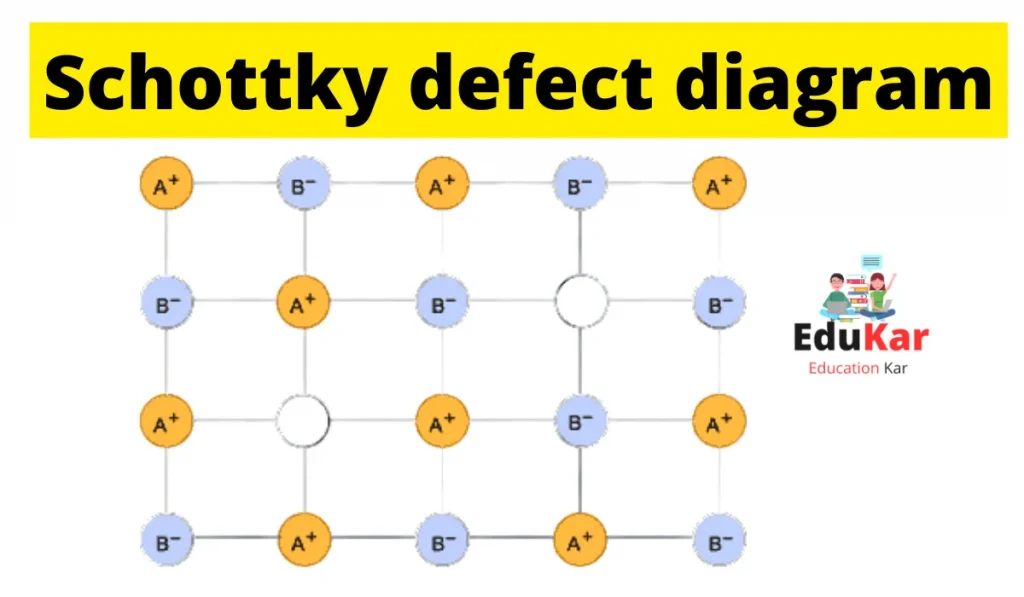Contents
Schottky defects are a special type of defect in semiconductors that arise due to a missing overlap of charge between two adjacent atoms. Here, the electron is missing because it’s captured by an ion. The key consequence of Schottky defect is that it can lead to the current becoming irregular and discontinuous. This blog will give an explanation about the Schottky defect.

Schottky Defect: Explained
The term Schottky Defect, sometimes called the Schottky effect, refers to the malleability of metals when they are subjected to electrical currents. It is also used in semiconductor devices, as well as other branches of electronics. The name Schottky is after the inventor, William Schottky. In modern terminology, the effect can be called the Schottky barrier.
What is the purpose of Schottky Defect?
Schottky defects are a type of short-circuit defect that can occur when metal is in contact with metal that has a higher work function than the metal. While metal can be made of many different types of materials, Schottky defects are most often seen in metal-oxide semiconductor (MOS) devices, such as in a diode, when it is in contact with a metal-oxide layer, such as aluminum oxide.
The Schottky defect is created when the metal-oxide layer, which is called the Schottky barrier, is higher than the work function of the metal. This causes electrons in the metal-oxide layer to be separated from holes in the metal, leading to a short-circuit and a Schottky effect.
Schottky defect diagram

What are the applications of Schottky Defect?
Schottky Defect refers to the property of electrical contacts at the junction of metals which allows them to conduct electricity with zero resistance. In the semiconductor industry, it is used to control the conduction between a p-type and n-type semiconductor.
What are some of the uses of Schottky Defect?
There are many ways in which Schottky defect can be used. They are commonly used in many types of semiconductors. They are also used in diodes, transistors, and other electronic devices. Schottky defects can be used as a channel between two contacts in a diode. They are also used in the creation of a Schottky contact. Schottky defects are also used in solar cells.
What are some of the drawbacks of Schottky Defect?
There are a few drawbacks of Schottky defect that you should know about.
First, Schottky defects are not as strong as other types of defects and therefore, they are not as good at conducting electricity. This means that Schottky defects require more voltage to sustain a current.
Second, Schottky defects are not as stable as other types of defects, meaning that the chip will be more likely to fail.
Finally, Schottky defects tend to form near the contact of two metals.
How to avoid Schottky Defect?
There are three things that you can do to avoid the Schottky Defect.
- The first is to use a Schottky diode with a different number of electrons.
- The second is to use a Schottky diode with a larger depletion layer.
- The third is to use a Schottky diode with a different type of material.
FAQs
What is Schottky defect formula?
Schottky defect formula is n = Ne E/2KT, where E is the energy required to create ‘n’ Schottky defects and K is the Boltzmann constant
What are the conditions of Schottky defect?
The condition of Schottky defect, in general, is when the electron is at a minimum energy and the momentum of the electron is zero.
Schottky defect example
Potassium Chloride (KCl), Potassium Bromide (KBr), Sodium Chloride (NaCl), Caesium Chloride (CsCl) and Silver Bromide (AgBr).
Conclusion
Schottky defect is a defect in the semiconductor material that can cause a power loss and affect efficiency. When a Schottky defect is present, electrons are not able to move due to the abnormally high voltage drop.
We hope you found our blog about Schottky Defect informational. Schottky Defects are a type of nanoscale defect in a semiconductor. They are named after the chemist who discovered them and are typically found in semiconductors. If you have any further questions or comments, please don’t hesitate to contact us anytime by visiting our website at www.edukar.in



![Carbon And Its Compounds Important Questions [Class 10] Carbon And Its Compounds Important Questions Class 10](https://edukar.in/wp-content/uploads/2022/09/Carbon-And-Its-Compounds-Important-Questions-Class-10-1024x597.webp)
![Web application and Security Class 10 [Questions Answers & MCQs] Web application Class 10 Questions & Answers](https://edukar.in/wp-content/uploads/2022/09/Web-application-Class-10-Questions-Answers-1024x597.webp)
![Zoology Important Questions [Class 11th-English medium] Zoology Important Questions class 10 english medium](https://edukar.in/wp-content/uploads/2022/09/Zoology-Important-Questions-class-10-english-medium-1024x597.webp)
![Corporate Accounting [Important Questions & Answers with MCQ] Corporate Accounting Important Questions & Answers](https://edukar.in/wp-content/uploads/2022/09/Corporate-Accounting-Important-Questions-Answers-1024x597.webp)
![What Is Colloidal Solution? [Class 9,10,11&12] What Is Colloidal Solution](https://edukar.in/wp-content/uploads/2022/08/What-Is-Colloidal-Solution-1024x597.webp)

![Biology Class 10 Very important [Questions &Answers] Biology Important Questions with Answers class 10](https://edukar.in/wp-content/uploads/2022/09/Biology-Important-Questions-with-Answers-class-10-1024x597.webp)

![What is Sublimation with Examples? [Class 9,10th,11th] What is Sublimation with Examples](https://edukar.in/wp-content/uploads/2023/03/What-is-Sublimation-with-Examples.webp)




